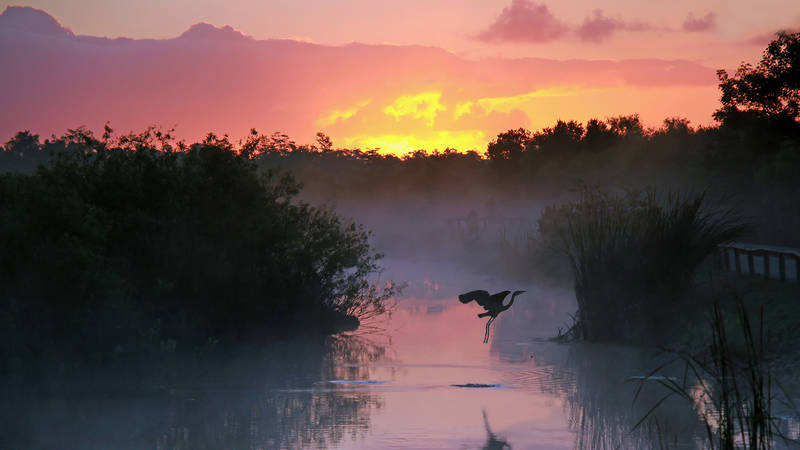It’s World Water Day and a great week for the Everglades. A new bridge will soon bring much-needed water to the park.
Today, March 22, we celebrate World Water Day. Officially sanctioned by the United Nations, this year’s theme is water cooperation, which recognizes the need to balance demands and priorities among multiple players involved in water management decisions.
Much of Everglades restoration is about water cooperation and finding appropriate management solutions to meet the many needs of those dependent on the ecosystem while restoring the historic “River of Grass.”
In the spirit of water cooperation, many partners came together this week to celebrate the completion and ribbon cutting of a one-mile bridge on Tamiami Trail, a major Everglades restoration project and the largest construction project in the history of the National Park Service (NPS). NPCA staff and board members joined with Secretary of the Interior Ken Salazar, Assistant Secretary of the Army (Civil Works) Jo-Ellen Darcy, and Everglades National Park Superintendent Dan Kimball on an inaugural crossing of the bridge.
Tamiami Trail (U.S. Highway 41/State Road 90) connects Tampa to Miami and forms a portion of the northern boundary of Everglades National Park. It provides access to one of the most popular areas of the park–Shark Valley Slough. The road is also the only way to access the Big Cypress National Preserve Visitor Center and Headquarters.

Everglades National Park
One of the largest wetlands in the world, this iconic “River of Grass” protects 1.5 million acres of subtropical wilderness in South Florida.
See more ›Since the road was built in the 1920s, Tamiami Trail has acted as a dam, cutting off the natural north-south water flow through the greater Everglades ecosystem. As a result, Everglades National Park is starved of vital water, deteriorating habitat for wading birds and other wildlife and altering the park’s unique ridge-and-slough landscape.
In 1989, Congress recognized the need for immediate restorative action and authorized a law known as the “Modified Water Deliveries project,” which included bridging this one mile of Tamiami Trail. Construction started 20 years after it was authorized. Finally, today, cars can drive over the bridge with water flowing underneath as they look south to the vast expanse of Everglades National Park.
We are thrilled that this first phase of bridging is finished and appreciate the many benefits it brings. This project is critical to restoring water flows and distribution that marine wildlife, fisheries, and nesting colonies of birds rely on, including the endangered Everglade Snail Kite and the Cape Sable Seaside Sparrow. Additionally, bridging Tamiami Trail will increase the capacity to move more water from Lake Okeechobee through the central Everglades, thus reducing the devastating water flows that are killing coastal estuaries, fueling red tides, and wasting billions of gallons of freshwater. People have benefitted directly from the project, too. The bridge construction already has brought much needed jobs to South Florida—from 2010 to 2012 alone, 1,212 jobs were created.
While park wildlife will feel the real, positive impact of some of these benefits in the near future, the one-mile bridge alone will not achieve the water flows necessary to restore the Everglades and truly reconnect the divided parts of the ecosystem. We must move forward with the additional bridging of Tamiami Trail.
According to the National Research Council’s “Progress Toward Restoring the Everglades: The Third Biennial Review,” additional bridging of Tamiami Trail is required to achieve significant ecological benefits. NPS recognizes this and has already recommended an additional 5.5 miles of bridging, which Congress authorized in 2012. The planning and design phase is underway right now at NPS’ Denver Service Center. The next critical step is securing funding for the project.
Everglades was the first national park dedicated for its biological diversity as opposed to its scenic vistas. However, as each year passes, its biological integrity is increasingly jeopardized by altered water flows. Each year we are losing critical habitat and endangered species.
Bridging Tamiami Trail is the highest priority project restoring an ecosystem in a national park. Now that the first mile is complete, we look to continuing this work with our partners, in the spirit of World Water Day’s theme of water cooperation, to build on this momentum and make a real difference for America’s Everglades.
Stay On Top of News
Our email newsletter shares the latest on parks.
For more information, see our recent press statement on the Tamiami Trail bridging and learn more about NPCA’s Great Waters program.
About the author
-
 Sarah Gaines Barmeyer Deputy Vice President, Conservation Programs
Sarah Gaines Barmeyer Deputy Vice President, Conservation ProgramsSarah Barmeyer is Deputy Vice President for NPCA’s Conservation Programs where she coordinates priority initiatives for water restoration, landscape conservation, wildlife, and clean air.
-
General
-
- Park:
- Everglades National Park
-
- NPCA Region:
- Sun Coast
-
-
Issues


